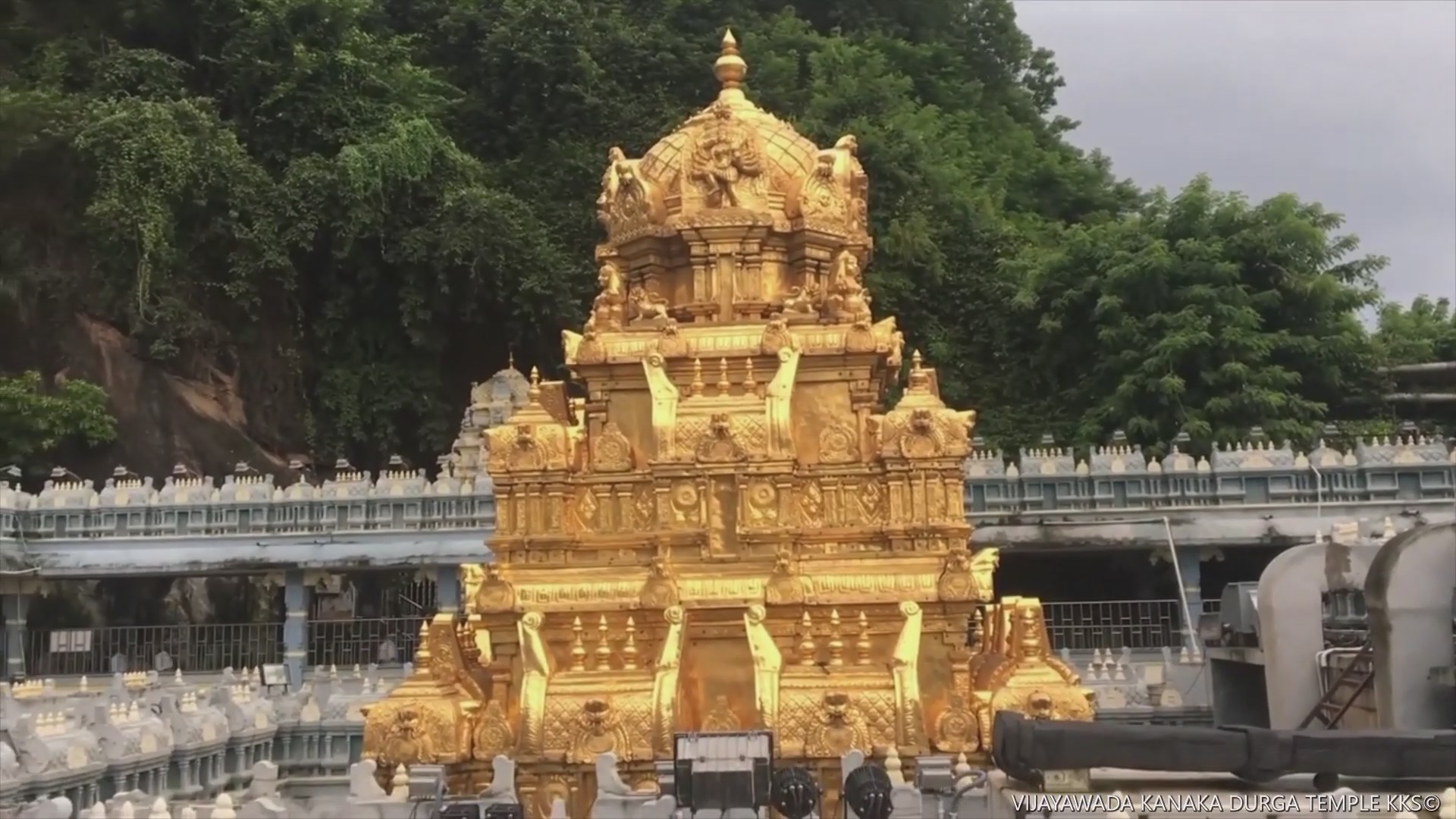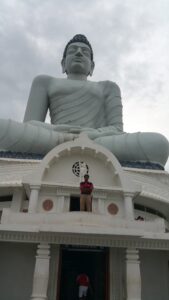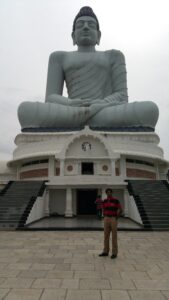
Kanaka Durga Temple is a famous hindu Temple of Goddess Durga located in Vijayawada, Andhra Pradesh. The temple is located on the Indrakeeladri hill, on the banks of Krishna River. Kaalika puraana, Durgaa sapthashati and other vedic literature have mentioned about Goddess Kanaka Durga on the Indrakeelaadri and have described the deity as Swayambhu, (self-manifested) in Triteeya kalpa
KANAKA DURGA TEMPLE – THE IMPRESSIVE MONUMENTAL TOWERS (GOPURAMS)
KANAKA DURGA TEMPLE – THE FLOAT FESTIVAL (TEPPOTSAVAM)
- Theppotsavam, or Theppothsava or float festival, is a Hindu religious festival carried out in Hindu temples in parts of South India, mainly Tamil Nadu during the month of Chitthirai or Aries
- As a part of this festival, the principal idol of the temples is decorated and taken in procession through the tank of the temple
Some of the temples where the float festival is celebrated are :
- Tirumala Venkateswara Temple
- Meenakshi Amman Temple, Madurai
- Samayapuram Mariamman Temple
- Simhachalam Temple, Visakhapatnam
- Kanaka Durga Temple, Vijayawada
- Thiyagarajar Temple, Thiruvarur
- Kolaramma Temple, Kolar, Karnataka
WHO IS GODDESS DURGA ?
- Durga (Sanskrit : दुर्गा – literally means “impassable”,”invincible, unassailable”,´´beyond defeat´´) identified as Adi Parashakti is a principal and popular form of the Hindu Goddess
- The meaning of Goddess Durga is derived from the sanskrit words
- Durg (दुर्ग) which means “fortress, something difficult to defeat or pass” and
- Durga is derived from the roots dur (difficult) and gam (pass through or go through)
DESCRIBE THE SYMBOLISM OF GODDESS DURGA ?
- Goddess Durga is a central deity in Shaktism tradition of Hinduism, where she is equated with the concept of ultimate reality called Brahman
- Goddess Durga is a goddess of war – the warrior form of Parvati whose mythology centres around combating evils & demonic forces that threaten peace, prosperity, and Dharma the power of good over evil
- Durga is also a fierce form of the protective mother goddess, who unleashes her divine wrath against the wicked for the liberation of the oppressed, and entails destruction to empower creation
WORSHIP & FESTIVALS OF GODDESS DURGA :
DURGA PUJA, NAVRATRI, DUSSERA, DASHAIN (NEPAL)
- Durga is revered after spring and autumn harvests, specially during the festival of Navratri
- Durga is worshipped in Hindu temples across India and Nepal by Shakta Hindus
- Her temples, worship and festivals are particularly popular in eastern and northeastern parts of Indian subcontinent during Durga puja, Dashain and Navaratri
- As per Markandya Puran, Durga puja can be performed either for 9 days or 4 days (last four in sequence)
- It is scheduled per the Hindu luni-solar calendar in the month of Ashvin and typically falls in September or October
- The day of Durga’s victory is celebrated as Vijayadashami (Bijoya in Bengali), Dashain (Nepali) or Dussehra (in Hindi) – these words literally mean “the victory on the Tenth (day)
DESCRIBE THE ATTRIBUTES & ICONOGRAPHY OF GODDESS DURGA
- Durga is depicted in the Hindu pantheon as a Goddess riding a lion or tiger, with many arms each carrying a weapon often defeating Mahishasura (literally : buffalo demon)
- Goddess Durga has been a warrior goddess, and she is depicted to express her martial skills
- Her iconography typically resonates with these attributes, where she rides a lion or a tiger, has between eight and eighteen hands, each holding a weapon to destroy and create
- She is often shown in the midst of her war with Mahishasura, the buffalo demon, at the time she victoriously kills the demonic force
- Her icon shows her in action, yet her face is calm and serene
- In Hindu arts, this tranquil attribute of Durga’s face is traditionally derived from the belief that she is protective and violent not because of her hatred, egotism or getting pleasure in violence, but because she acts out of necessity, for the love of the good, for liberation of those who depend on her, and a mark of the beginning of soul’s journey to creative freedom
- Durga traditionally holds the weapons of various male gods of Hindu mythology, which they give her to fight the evil forces because they feel that she is the shakti (energy, power)
- These include chakra, conch, bow, arrow, sword, javelin, shield, and a noose
- These weapons are considered symbolic by Shakta Hindus, representing self-discipline, selfless service to others, self-examination, prayer, devotion, remembering her mantras, cheerfulness and meditation
- Durga herself is viewed as the “Self” within and the divine mother of all creation
- She has been revered by warriors, blessing their new weapons
- Durga iconography has been flexible in the Hindu traditions, where for example some intellectuals place a pen or other writing implements in her hand since they consider their stylus as their weapon
GODDESS DURGA
- Affiliation
- Adi-Parashakti
- Sati
- Parvati
- Ambika
- Kaushiki
- Mahakali
- Bhagavati
- Chandi
- Weapons
- Chakra (discus)
- Shankha (conch shell)
- Trishula (Trident)
- Gada (mace)
- Bow and Arrow
- Khanda (sword) and Shield
- Ghanta (bell)
- Mount : Tiger or Lion
- Festivals : Durga Puja, Durga Ashtami, Navratri, Vijayadashami
Personal information
- Siblings : Ganga as elder sister, Vishnu as elder brother
- Consort : Shiva
- Children : Kartikeya, Ganesha, Ashok Sundari
DESCRIBE THE INFLUENCE OF GODDESS DURGA
- Durga is a major goddess in Hinduism, and the inspiration of Durga Puja – a large annual festival particularly in the eastern and northeastern states of India
- One of the devotees of her form as Kali was Sri Ramakrishna who was the guru of Swami Vivekananda. He is the founder of the Ramakrishna Mission
GODDESS DURGA IS THE INSPIRATION BEHIND
VANDE MATARAM – THE NATIONAL SONG OF INDIA
&
BHARAT MATA – THE NATIONAL PERSONIFICATION OF INDIA AS A MOTHER GODDESS
INSPIRATION BEHIND VANDE MATARAM
THE NATIONAL SONG OF INDIA
- Durga as the mother goddess is the inspiration behind the song Vande Mataram, written by Bankim Chandra Chatterjee, during Indian independence movement
- Parts of the Vande Mataram was chosen as the national song in 1937 – The Indian National Congress decided to adopt only the first two stanzas as the national song to be sung at public gatherings, and other verses that included references to Durga and Lakshmi were expunged
- So the first two verses of the song were adopted as the National Song of India
- On 24 January, 1950, the Constituent Assembly of India has adopted “Vande Mataram” as national song
- On the occasion, the first President of India, Rajendra Prasad stated that the song should be honoured equally with the national anthem of India, “Jana Gana Mana”
- However the Constitution of India does not have any mention of “national song”
INSPIRATION BEHIND BHARAT MATA
THE NATIONAL PERSONIFICATION OF INDIA AS A MOTHER GODDESS
- The concept of Bharat Mata as the personification of the Indian subcontinent came into existence starting in the late 19th century, especially after the Indian Rebellion of 1857 against the British
- Bharat Mata as a concept was first perceived to be an image of the land of India as depicted by Bankimchandra Chatterjee in his book Anand Math in 1882
- Abanindranath Tagore portrayed Bhārat Mātā as a four-armed Hindu goddess wearing saffron-colored robes, holding the manuscripts, sheaves of rice, a mala, and a white cloth
- Bhārat Mata (Hindi, from Sanskrit Bhāratamba भारताम्बा; अम्बा ambā means ‘mother’, also known as Mother India in English) is the national personification of India as a mother goddess
- She is usually depicted as a woman clad in a saffron sari holding the Indian national flag, and sometimes accompanied by a lion
- Durga is present in Indian Nationalism where Bharat Mata i.e. Mother India is viewed as a form of Durga’
- This is completely secular and keeping in line with the ancient ideology of Durga as Mother and protector to Indians
- Any woman who takes up a cause to fight for goodness and justice is said to have the spirit of Durga in her
- There are Bharat Mata temples in Varanasi (Benares), Hardwar, Kolkata and announcement made to construct one in Kurukshetra
 Bharat Mata at Jatiya Shaktipeeth, Kolkata
Bharat Mata at Jatiya Shaktipeeth, Kolkata
- The motto Bharat Mata ki Jai’ (“Victory for Mother India”) is used by the Indian Army
- In Muslims majority Indonesia’s several dozen national armed units also use hindu-origin sanskrit language mottoes, including the National Armed Forces, Army, Navy
- In Indonesia – for example the Indonesian Air Force’s motto Swabhuana Paksa (“Wings of The Motherland”) and the Indonesian National Police’s motto Rastra Sewakottama or “राष्ट्र सेवकोत्तम” (“Nation’s main servants”)
- In Indonesia – The National emblem is Garuda and National ideology is pancasila (both Indian / sanskrit influence & inspiration)
GODDESS DURGA – INFLUENCE IN OTHER CULTURES
 Goddess Durga in Southeast Asia, from left: 7th/8th century Cambodia, 10/11th century Vietnam, 8th/9th century Indonesia
Goddess Durga in Southeast Asia, from left: 7th/8th century Cambodia, 10/11th century Vietnam, 8th/9th century Indonesia
- In Indonesia :
- On the island of Java, have yielded numerous statues of Durga (at least 135) dated from 6th century onwards
- In Muslims majority Indonesia’s several dozen national armed units also use hindu-origin sanskrit language mottoes, including the National Armed Forces, Army, Navy
- In Indonesia – for example the Indonesian Air Force’s motto Swabhuana Paksa (“Wings of The Motherland”) and the Indonesian National Police’s motto Rastra Sewakottama or “राष्ट्र सेवकोत्तम” (“Nation’s main servants”)
- In Indonesia – The National emblem is Garuda and National ideology is pancasila (both Indian / sanskrit influence & inspiration)
- In Vietnam & Cambodia – numerous statues were found – However, most differ from the Indian representation in one detail. The Cambodian Durga iconography shows her standing on top of the cut buffalo demon head
- In Mauritious – Durga Mata Statue in Ganga Talao in Mauritius (below)

- In Bangladesh – the 4 day long Sharadiya Durga Puja – most important religious festival for the Hindus & Vijayadashami being a national holiday
- In Sri Lanka – Durga in the form of Vaishnavi, bearing Vishnu’s iconographic symbolism is celebrated
- In Buddhism
- In Tibetan Buddhism – the goddess Palden Lhamo is similar to the protective and fierce Durga
- In Japanese Buddhism – she appears as Butsu-mo (sometimes called Koti-sri)
- In Jainism :
- The Sacciya mata found in major medieval era Jain temples mirrors Durga
- In the Ellora Caves, the Jain temples feature Durga with her lion mount. However, she is not shown as killing the buffalo demon in the Jain cave, but she is presented as a peaceful deity
KANAKA DURGA
LEGEND OF THE GODDESS
- According to a legend, the now verdant Vijayawada was once a rocky region strewn with hills that obstructed the flow of River Krishna
- The land was thus rendered unfit for habitation or cultivation
- Invocation to Lord Shiva for His intervention directed the hills to make way for the river
- And the river started flowing unimpeded with all its might, through the tunnels or “Bejjam” bored into the hills by Lord Shiva. That is how the place got its name Bezawada
- One of the many mythologies associated with this place is that Arjuna prayed to Lord Shiva on top of Indrakeela hill to win His blessings and the city derived its name “Vijayawada” after this victory
- Another popular legend is about the triumph of goddess Kanakadurga over the demon King Mahishasura
- It is said that the growing menace of demons became unbearable for the natives
- Sage Indrakila practiced severe penance, and when the goddess appeared the sage pleaded Her to reside on his head and keep vigil on the wicked demons
- As per his wishes of killing the demons, Goddess Durga made Indrakila Her permanent abode
- Later, She also slayed the demon king Mahishasura freeing the people of Vijayawada from evil
- At the Kanakadurga temple, the enchanting 4-foot-high (1.2 m) icon of the deity is bedecked in glittering ornaments and bright flowers
- Her icon here depicts Her eight-armed form -each holding a powerful weapon- in a standing posture over the demon Mahishashura and piercing him with Her trident
- The goddess is the epitome of beauty
- Adjacent to the Kanakadurga temple is the shrine of Malleswara Swamy on the Indrakeeladri
- By ascending the steps on the hill, one comes across little images of different deities, prominent among them are Kanaka Durga, Malleswara and Krishna(River)
KANAKA DURGA TEMPLE DESCRIPTION
Kanaka Durga Temple is synonymous with Vijayawada. It is mentioned in the sacred texts
- This is the place where Arjuna obtained the Pasupatha astra after his great penance for Lord Shiva
- The temple was constructed for Goddess Durga by Arjuna
- It is connected by steps and a ghat road
- The temple occupies an important place in the scriptures as several of the Siva-leelas and Shakti-mahimas were enacted on or around it, making the region a place of unequaled spiritual significance and attracting pilgrims since times immemorial
- It is mentioned in the hindu scriptures that the deity in the Kanakadurga temple is regarded as ‘Swayambhu’ or self-manifested, hence considered very powerful
- Inscriptions of different dynasties are found in the temple
DASARA / NAVARATRI CELEBRATIONS
- Special pujas are performed during Dasara also called Navaratri
- The most significant are Saraswati puja and Theppotsavam
- The festival of Dasara for Goddess “Durga” is celebrated here every year
- A large number of pilgrims attend the colourful celebrations and take a holy dip in the Krishna river
TRANSPORT – REACHING THE TEMPLE
 Durga Temple-Vijayawada
Durga Temple-Vijayawada- Located in the heart of Vijayawada city, the temple is just a 10 minutes drive from the railway station and Bus stand and about 20 km from airport
- Temple buses are available at bus stand and railway station for every 20 minutes
- Vijayawada is located 275 kilometers from Hyderabad
- Vijayawada is well connected by road, rail and air from all parts of the country
DASARA FESTIVITIES
- Sri Kanaka Durga Devi, the chief deity of the temple is portrayed as blessing the visiting devotees in various forms (avatars) during the ten-day festival
- A symbolic representation of the 10 forms of triumph of good over evil, this form (known as ‘Alankaram’) of the day is chosen as per the astrological star of each day, in accordance with the lunar calendar
- SRI SWARNA KAVACHALAKRUTA DURGA DEVI
- SRI BALA TRIPURA SUNDARI DEVI
- SRI ANNAPURNA DEVI
- SRI GAYATRI DEVI
- SRI LALITHA TRIPURA SUNDARI DEVI
- SRI SARASWATI DEVI
- SRI MAHA LAKSHMI DEVI
- SRI DURGA DEVI
- SRI MAHISHASURA MARDHINI DEVI
- SRI RAJA RAJESWARI DEVI
Note: Alankarams may change according to Thidis and nakshatrams every year
కనకదుర్గ గుడి
- కనకదుర్గ గుడి, ఆంధ్ర ప్రదేశ్, భారతదేశంలో ఒక ప్రసిద్ధమైన దేవస్థానం
- కనకదుర్గ గుడి విజయవాడ నగరంలో కృష్ణా నది ఒడ్దున ఇంద్రకీలాద్రి పర్వతం మీద ఉంది
- కనకదుర్గ గుడి ఆంధ్రప్రదేశ్ రాష్ట్రంలోనే రెండో పెద్ద దేవాలయం
- విజయవాడ పేరు చెప్పగానే కనక దుర్గ ఆలయం గుర్తుకు వస్తుంది
- హిందూ పురాణాలలో అమ్మవారి గురించి ప్రస్తావన ఉంది
- ఆలయంలో అమ్మవారి విగ్రహం సుమారు నాలుగు అడుగుల ఎత్తు ఉంటుంది
- మిరిమిట్లు గొలిపే ఆభరణాలు, పూలతో అలంకరించబడి ఉంటుంది. మూర్తికి ఎనిమిది చేతులు ఉన్నాయి
- ఒక్కో చేతిలో ఒక్కో ఆయుధం ఉంటుంది. త్రిశూలంతో మహిషాసురుని గుండెలో పొడుస్తున్న భంగిమలో ఉంటుంది
కనకదుర్గ గుడి
పేరువెనుక చరిత్ర
- కృతయుగానికి పూర్వం కీలుడు అనే యక్షుడు అమ్మావారుని గురించి తపస్సు చేసి, ప్రత్యక్షం చేసుకుని ఆమెను తన హృదయస్థానంలో నిలిచి ఉండమని కోరాడు
- అమ్మవారు కీలుని పర్వతంగా నిలబడమని కృతయుగంలో రాక్షస సంహారం చేసిన తరువాత తాను ఆ పర్వతం మీద నిలిచి ఉంటానని మాటిచ్చింది
- కీలుడు కీలాద్రిగా మారి అమ్మవారి కొరకు ఎదురుచూస్తూ ఉన్నాడు. అమ్మవారిని సేవించుకోవడానికి ఇంద్రాది దేవతలు ఇక్కడకు తరచూ రావడం వలన కీలాద్రి ఇంద్రకీలాద్రిగా మారింది
- ఇక్కడ వెలసిన మహిషాసురమర్ధిని ఆమె కనకవర్ణంతో వెలుగుతున్న కారణంగా కనక దుర్గ అయింది. ఇక్కడ అర్జునుడు శివుడి కొరకు తపస్సు చేసి శివుడి నుండి పాశుపతాస్త్రాన్ని పొందాడు
- కనుక ఈ ప్రాంతం విజయవాడ అయింది
కనకదుర్గ గుడి
క్షేత్ర పురాణం
- శ్రీ దుర్గా మల్లేశ్వర స్వామి వారి దేవస్ధానం కృష్ణానది ఒడ్డునే ఉన్న ఇంద్రకీలాద్రి పర్వతం పైన ఉంది
- ఇక్కడ దుర్గా దేవి స్వయంభువుగా (తనకు తానుగా) వెలసిందని క్షేత్ర పురాణంలో చెప్పబడింది
- ఆది శంకరాచార్యులవారు తమ పర్యటనలలో ఈ అమ్మవారిని దర్శించి ఇక్కడ శ్రీచక్ర ప్రతిష్ఠ చేసారని ప్రతీతి
- ప్రతి సంవత్సరం కొన్ని లక్షలమంది ఈ దేవాలయానికి వచ్చి దర్శనం చేసుకొంటారు
 కనకదుర్గ అమ్మవారి విగ్రహము
కనకదుర్గ అమ్మవారి విగ్రహము- రాక్షసుల బాధ భరించ లేక ఇంద్రకీలుడనే మహర్షి దుర్గాదేవిని గురించి తపస్సు చేసి అమ్మవారిని తనపైనే నివాసముండి రాక్షసులను సంహరించమని ప్రార్థించగా, ఆ తల్లి అక్కడ ఇంద్రకీలాద్రి (ఇంద్రకీలుడి కొండ) పై కొలువుతీరింది
- అర్జునుడు ఈ కొండ పై శివుని గురించి తపస్సు చేసాడని కూడా ప్రతీతి. ఈ ఆలయానికి హిందూ పురాణాల్లో ప్రత్యేకమైన స్థానం ఉంది. శివలీలలు, శక్తి మహిమలు మొదలైనవి ఆలయంలోని ఆవరణలో అక్కడక్కడా గమనించవచ్చు
కనకదుర్గ గుడి
నవరాత్రి ఉత్సవాలు
ఈ దుర్గాదేవి అమ్మవారికి ప్రతి సంవత్సరము దసర నవరోత్సవాలు జరుగుతాయి. ఈ దసర నవరోత్సవల లో ప్రతి రోజు ఒక అవతారముతో దర్శనము ఇస్తారు. ఈ తొమ్మిది రోజులు తొమ్మిది అవతారాలతో దర్శనము ఇస్తారు
- మొదతి రోజు బాల త్రిపురసుందరి దేవి .
- రెండొవ రోజు గాయత్రి దేవి.
- ముడొవ రోజు అన్నపూర్ణా దేవి.
- నాలుగోవ రోజు లలితా త్రిపురసుందరి దేవి.
- ఐదవ రోజు సరస్వతి దేవి .
- ఆరొవ రోజు దుర్గాదేవి.
- ఎడొవ రోజు మహాలక్ష్మిదేవి.
- ఎనిమిదొవ రోజు మహిషాసురమర్దినిదేవి.
- తొమ్మిదొవ రోజు రాజరాజేశ్వారిదేవి
- ఈ ఐదొవ రోజున జరిగే సరస్వతి అమ్మవారి అలంకరణ రోజు అమ్మవరి జన్మనక్షత్రంగా అనగా ములానక్షత్రం గా భావిస్తారు
- ఆ రోజున వేలాది మంది భక్తులు, విద్యార్థులు తరలివస్తారు. ఈ దేవాలయంలో వినాయక స్వామి, ఈశ్వరుడు, శ్రీ రాము ల వారు కొలువుతీరి ఉన్నారు
- ఈ దేవాలయాన్ని దర్సించుటకు అనేక మంది భక్తులు అనేక ప్రదేశాల నుండి వస్తారు


